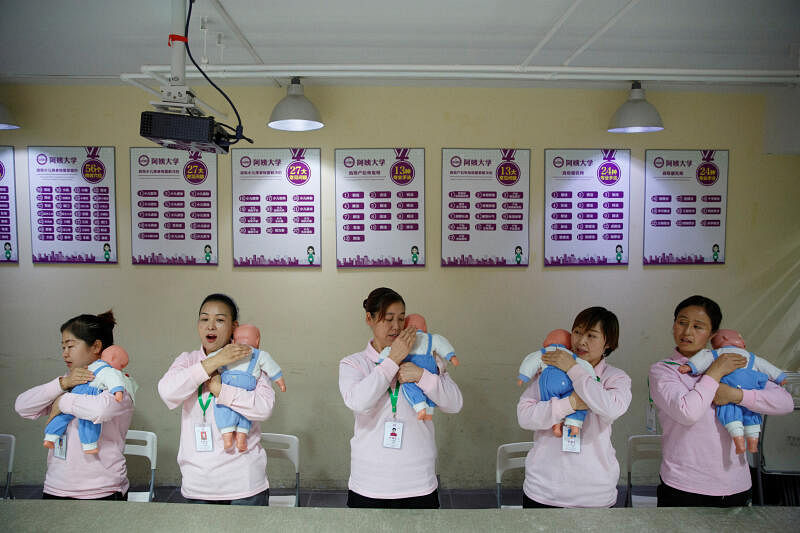
Under the continuous prevention and control measures of crown disease, the number of marriage registered in China is going downhill.
According to the data released recently by the Ministry of Civil Affairs of China, in the second quarter of this year, the number of marriage registered was 1.625 million pairs, compared with 20.34 million in the second quarter of 2021, a decrease of 20%year -on -year.The decrease of 10%to 3.7 million pairs was the lowest semi -annual data since the Ministry of Civil Affairs began to announce the quarterly registered data.
The marriage registration data in the first half of the year is usually released in July or August each year.The Ministry of Civil Affairs has not explained why the data was released in the first half of this year.
Chinese population expert Yi Fuxian analyzed the interface news that after the epidemic in early 2020, the marriage registration in the first quarter decreased sharply, and a slight recovery in the second quarter.Since the beginning of this year, under the influence of the large -scale spread of the newly variable coronary virus, Omircor, in the second quarter, some regions have implemented control and control, resulting in the number of marriage in the second quarter decreased by 20%year -on -year and a decrease of 23%month -on -month.

The Ministry of Civil Affairs issued a statistical bulletin earlier, showing that the number of marriage people in China has fallen for eight years, and the number of weddings over 30 years old accounts for nearly half.The bulletin also shows that in 2021, the annual marriage registration was 7.643 million, a decrease of 6.1%over the previous year.This is also the lowest number since the official start to record in 1986.
Generally believes that the economic impact of the epidemic in the past three years is the main cause of the decrease in the number of marriage registration in China in recent years.
In the first three quarters of this year, the Chinese economy increased by only 3 % year -on -year, and it is expected that the official setting of about 5.5 % of the growth goals cannot be achieved throughout the year.
According to Japanese Nomura estimates, as of November 21, about 20%of cities that contributed to the GDP of China have adopted some form of control measures.About 412 million people were influenced by these restrictions last week, higher than the 340 million people in the previous week.
Considering the recent epidemic, some economists have lowered their expectations for China's economic growth.Lu Ting, the chief Chinese economist in Hong Kong in Hong Kong, said in a report to customers on November 24 that he expects that China's economy in the fourth quarter will shrink 0.3%month -on -month.He will reduce the expected economic growth throughout the year from 2.9%to 2.8%.
At the same time, analysts of the Oxford Economic Research Institute believe that the scope of the Chinese government's blockade measures will expand, and the growth rate of domestic GDP in 2022 and 2023 will be reduced.

Facing the uncertainty brought about by economic slowdown, some young Chinese people have put on hold on major life plans, including marriage.
The Wall Street Journal quoted King Judi, a 20 -year -old Hebei, said that she was a top priority to find a job, not getting married.After losing her job at a convention and exhibition company, she said that at least three job opportunities were soaked in the restrictions on epidemic prevention. Some were because she missed the interview, some because the employer canceled her position.She said she only wanted one job.
According to the official investigation of urban residents, the unemployment rate of young people aged 16 to 24 in October was 17.9%, which was the same as September.In July, the unemployment rate of youth from 16 to 24 is 19.9 %, which is the highest level since the official announcement.In other words, there is an unemployment in every five young people in China.
Ye Wenzhen, vice president of the Chinese Women's Research Association and a part -time professor at Xiamen University, said in an interview with Chinese Women's newspapers that the decrease in the number of marriage in 2021 was obviously affected by the epidemic.He emphasized that with the economic downturn, revenue and employment were affected. There were a house and a car in the traditional Chinese concept of marriage. This gave young people a lot of pressure.The dilemma of "can't afford to get married" still cannot be relieved to a certain extent.
In addition, Ye Wenzhen believes that the emotional exchanges of young people during the epidemic are reduced, and it is difficult to prepare for weddings and host a wedding banquet. It will also have a downlink and delayed impact on the occurrence of marriage and marriage.
The environment allows young people to make a step forward to enter the marriage hall. The Chinese government has previously tried to protect marriage by setting up more obstacles for divorce.
In May 2020, the Chinese National People's Congress voted and approved the Civil Code.This Chinese first civil code was implemented in January 2021, and the "Divorce Calm Calm Period" listed, setting a 30 -day cooling period for the divorce couple.
This measure was considered by the outside world to play a role, which reduced the number of divorce registration in 2021 from 3.7 million to 2.1 million in 2020.
However, the above data is limited to the so -called "agreement divorce". This kind of divorce is handled by the Civil Affairs Bureau and the illegal court. The divorce in the court may have a long legal lawsuit.
Therefore, the New York Times quoted Mai Yisheng, an expert at the University of Indiana studying the Chinese Marriage Law and gender inequality, said that the decline in the divorce rate may be related to the difficulty of scheduling a divorce appointment during the epidemic.
"Agreement Divorce" type requires that both parties to apply for divorce in person.After a 30 -day calm period, the couple must be present in person, otherwise the divorce application will be withdrawn.The difficulty of blocking and social distance regulations has increased the difficulty of applying for "agreement divorce", but it does not mean that people who want to divorce have decreased. They are just "inseparable from marriage."
The impact of the epidemic is not only reflected in the number of marriage registrations and the number of divorce, but also a phenomenon of decline in fertility.

In 2020 when the crown disease epidemic was outbreak, the birth rate of the national population in China (that is, the ratio of the number of births per thousand people) fell below 10 ‰ for the first time, reaching only 8.52 ‰, setting a new low in 1978; this number was further further in 2021The decline reached 7.52%.
According to Reuters in August, the National Health and Health Commission of China wrote in the response to Reuters' fertility rate in response to the issue of Chinese fertility rate. Many women continue to postpone their plans to get married and have children.Bring "profound changes."The Health Commission also shows that the crown disease has a significant impact on the arrangement and fertility of some people.
Economic and social costs caused by epidemic prevention measures have continued to rise.The incident is provocative.
In the past weekend, major cities in China, Beijing, Beijing, Chengdu, Xi'an, Wuhan and other major cities have erupted protests against strict epidemic prevention measures.The incident fuse is a fire in a residential area in Urumqi, Xinjiang on November 24, causing ten people to die.Online public opinion speculated that the sealing measures hindered the rescue.
The English version of the Global Times published an article on the evening of November 27, accusing Western media of inciting dissatisfaction with Chinese epidemic prevention policies.
This article entitled "Western Media Badmouth China's Epidemic Like How Washington Fans the Flames in Russia-Ukraine Conflict" (Chinese translation is: Western media abuses the Chinese epidemic, just like Washington in Russia in Russia Article of the conflict), quotingProfessor Shen Yi of Shanghai Fudan University wrote: "Due to the differences in ideology, Western countries and the media criticized the Communist government to become an instinct to subvert the government with a color revolution."
He also added that in the game of great powers, the objective facts of China and the West have different in response to the epidemic, which has caught the West in a state of anxiety."Therefore, they are anxious to capture, exaggerate and accuse them of all negative problems found in the process of Chinese epidemic control."
The article finally wrote that China's epidemic prevention measures for epidemic situation have never been static. As the situation changes, it is also constantly adjusting in a good direction.
Hu Xijin, the former editor -in -chief of the Global Times, also holds the same argument.He posted on Weibo on the afternoon of November 28, mentioning that there were some things in China in the past two days, and believed that there should be some effects of factors outside the scene.
Hu Xijin said, "We need to understand that these external factors exist all the year round. They are a constant. Even when Chinese and Western relations are relatively good, those factors have never left. In the same wayIt may be possible to decide when the matter is floating on the water, how fast the transmission speed can be, and so on. In other words, external causes need to find the cause of the internal cause to make a situation, so as not to do it. "
Hu Xijin also described things itself is complex, but believes that society and the government may wish to face its complexity calmly and cope with corresponding methods.He said: "We need to block, eliminate external factors, adjust and improve internal factors, eventually promote the proper solution of things, and create more positive conditions for the long -term security of society."
The strict dynamic zero -zero policy has continued to implement it for a long time, which has caused a huge impact on society and economy, forming a phenomenon of low economic growth, low marriage rate, and low fertility rate.After the public thought that optimizing the epidemic prevention policy, the days when they would be able to welcome great liberalization. The higher the expectations, the easier it was to be anxious.The various "knots" formed under the formation of China's epidemic need to be gradually solved. The bells must be tied to the bell. Next, it depends on the official political wisdom.




